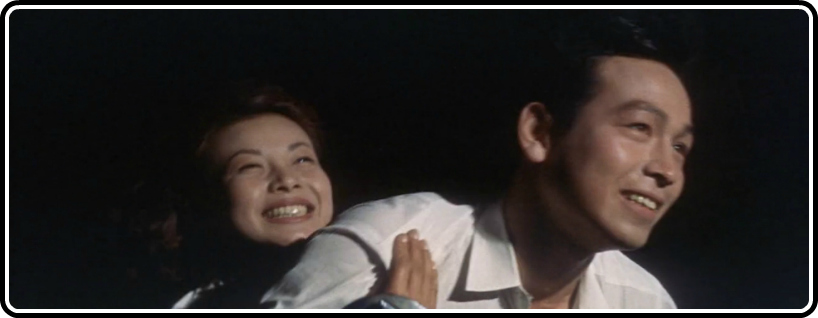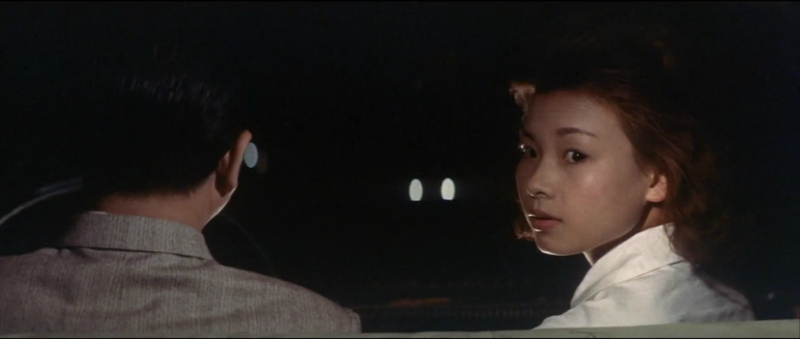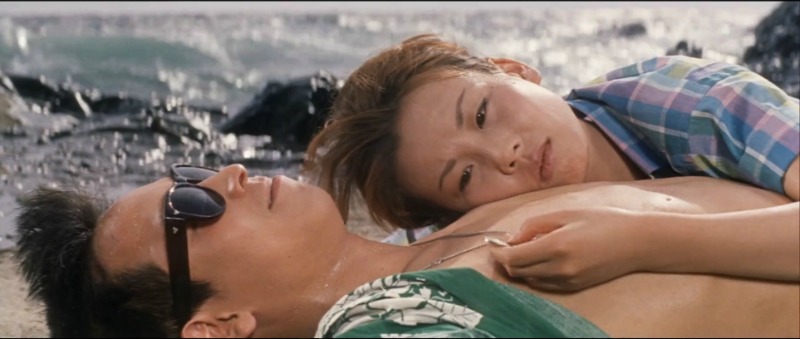
Man, and you thought the French were ahead of the curveball in depicting 1960s youth culture. That Cruel Story of Youth should exist seems almost second-nature, so forcefully does it emerge from an untapped sense of dissatisfaction and sexual awakening; that it came out in 1960 seems otherworldly. It’s so raw, it’s almost primal. It’s so explicit, it need not show that which it explicates. And as introductions to Oshima go, you could hardly ask for better (it was mine, and it being his debut feature makes it doubly fitting).
The film is informally structured around a series of of violent sexual encounters. We meet Makoto (Miyuki Kuwano) as she’s hitching for a ride home with one of her friends. An older man picks them up, and after dropping the friend off, attempts first to lure Makoto into his bed, and then, when that fails, to rape her. He’s interrupted by a stranger passing by, who violently assaults him and attempts to take him to the police, until the would-be rapist offers up some money and is sent packing. That Makoto’s association with Kiyoshi (Yasuke Kawazu), her young rescuer, should end there seems obvious, yet their almost assumed meeting the next day, and the ensuing events, belies one of the film’s many themes – society bills women for merely existing. Because she was in a car with a stranger who offered to help, she was nearly raped. Because she was rescued, she goes on a date. Because she goes a date, she then is actually raped. And things don’t get a whole lot less cruel from there.

Beyond the duck-and-dodge method in which Makoto and Kiyoshi fall in “love,” their inseparability becomes almost reflexive. Neither seems to really like the other, but they can’t walk away (ah, young love), especially once their extracurricular activities turn criminal. Using their initial meeting as a template, they extort sexual predators whenever they want a night on the town, but Oshima’s presentation of these escapades is deft, rather than exploitative. He shows only a couple key encounters, each time focusing on Makoto’s evolving response to them. Her habit of riding in cars with strange men is repeatedly turned on its head, reversed, and tumbled until it’s hard to conceive of how this could have ever been a good idea. And yet we’re told right at the beginning of the film that we’re not even seeing her first such ride – was she fortunate before, or is all of this much more familiar than she’s letting on?
Certainly her resistance to Kiyoshi’s aggressive pursuit seems genuine, and as much as the film could be accosted for misogyny (this is, on the surface, a story of a girl who falls in love with her rapist), it’s important to note where Oshima points his camera, almost always to the most emotionally vulnerable person in the scene. Usually that’s Makoto, but when the tables turn, his framing underscores these developments. For such often-outlandish subject matter, Oshima’s direction is purely classical, and so richly assured not only for a feature debut, but for any young filmmaker (the man himself was in his late twenties at the time).

Oshima is pretty well-represented within the Criterion Collection, with three mainline releases bearing his name, and an Eclipse set of five other films from the 1960s to keep them company, but they’ve yet to find a forum to present his very first. For now, their HD streaming version on Hulu makes for beautiful company. Presenting the film in its original, anamorphic aspect ratio of 2.35:1, the transfer gorgeously represents his bold color schemes and careful framing, without making either the center of the frame or the squished edges suffer for them – the frame truly looks optical, not digital.
Should Criterion decide to give this the bump to Blu (and as fine as their HD stream looks, a Blu-ray would be so awesome), it’d certainly be well worth all of our time to investigate the then-burgeoning youth movement in Japanese cinema in the form of visual essays or documentaries, and possibly bolster the release with Oshima’s previous shorts (one of which – A Town of Love and Hope – is practically a feature at 62 minutes). I know I’m not the only one who sees those “bonus” films as much more than bonuses – they’re just as integral to the release.

In the meantime, head on over to Criterion’s Hulu page and check out yet another classic film of the hundreds they’ve made available. I’m constantly reeling from the service, both for its promises and its frequent deliveries.



![Bergman Island (The Criterion Collection) [Blu-ray]](https://criterioncast.com/wp-content/uploads/2022/11/bergman-island-the-criterion-collection-blu-ray-400x496.jpg)
![This Is Not a Burial, It’s a Resurrection (The Criterion Collection) [Blu-ray]](https://criterioncast.com/wp-content/uploads/2022/11/this-is-not-a-burial-its-a-resurrection-the-criterion-collection-blu-ray-400x496.jpg)
![Lars von Trier's Europe Trilogy (The Criterion Collection) [The Element of Crime/Epidemic/Europa] [Blu-ray]](https://criterioncast.com/wp-content/uploads/2022/11/lars-von-triers-europe-trilogy-the-criterion-collection-the-element-of-400x496.jpg)
![Imitation of Life (The Criterion Collection) [Blu-ray]](https://criterioncast.com/wp-content/uploads/2022/11/imitation-of-life-the-criterion-collection-blu-ray-400x496.jpg)
![The Adventures of Baron Munchausen (The Criterion Collection) [4K UHD]](https://criterioncast.com/wp-content/uploads/2022/11/the-adventures-of-baron-munchausen-the-criterion-collection-4k-uhd-400x496.jpg)
![Cooley High [Criterion Collection] [Blu-ray] [1975]](https://criterioncast.com/wp-content/uploads/2022/11/cooley-high-criterion-collection-blu-ray-1975-400x496.jpg)